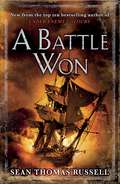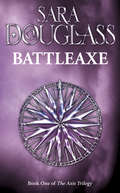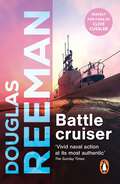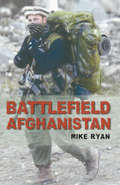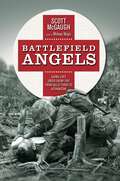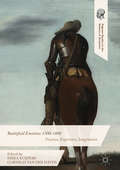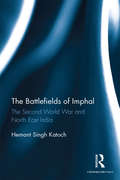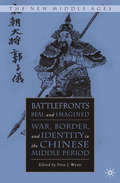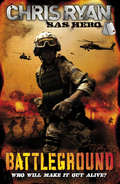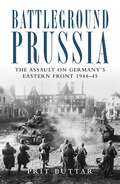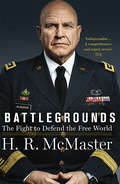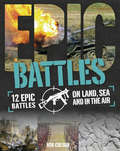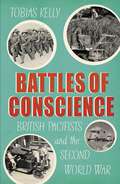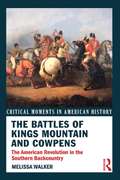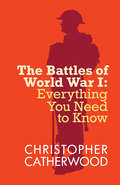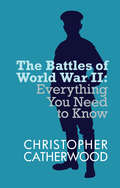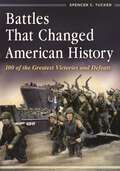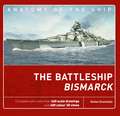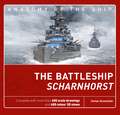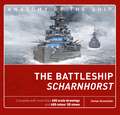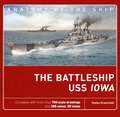- Table View
- List View
A Battle Won: Charles Hayden Book 2 (Charles Hayden #2)
by Sean Thomas RussellWinter 1793 - the Reign of Terror rips through revolutionary France, as every able-bodied man is pressed into military service. The city of Toulon has turned itself over to the British - the red ensign of Lord Admiral Hood's flagship, Victory, offering a defiant symbol of protection to its people. In Plymouth, Master and Commander Charles Hayden is summoned to the port admiral - his orders are to return to the ill-fated frigate, HMS Themis. Placed in temporary command, he is to join the escort for the last convoy of the season - braving the wintry seas to supply Hood's fleet in the Mediterranean. Hayden's uncanny knack for attracting the attention of the French navy sees the Themis thrown back into action only hours out of port. Soon, Hayden's captaincy and military skill are stretched to their utmost as he finds himself at the vanguard of this brutal clash of empires.
Battleaxe: Book One Of The Axis Trilogy
by Sara DouglassEpic fantasy in the tradition of Trudi Canavan, Fiona McIntosh and Robert Jordan.
Battlecruiser: an adrenaline-fuelled, all-action naval adventure from the master storyteller of the sea (The\modern Naval Fiction Library #4)
by Douglas ReemanThe Battlecruiser - in their time this class of ships was considered one of the great triumphs of the Royal Navy, as swift as a destroyer but packing a deadly firepower equal to any ship afloat. But the ships had one fatal flaw: their armour could be pierced by a single enemy shell. The Battle of Jutland exposed this Achilles' heel, then further disasters followed in the next world war with the tragic sinkings of the Hood and Repulse.1943 - Of all her class, HMS Reliant and one other have survived. Reliant has the reputation of a lucky ship but when Captain Guy Sherbrooke joins her he knows he could be her last captain. As Britain prepares to invade occupied Europe, Reliant will be thrown head first into the conflagration. All those who sail in her know that there can be no half measures: only death or glory awaits HMS Reliant.
Battlefield Afghanistan
by Mike RyanFrom interviews with his numerous contacts among the coalition forces stationed in Afghanistan, Mike Ryan has done what journalists have so far been unable to do. Battlefield Afghanistan is the first thorough-going account of the war in the former Taliban state: not the politics behind the conflict, but the actual situation for the men on the ground. Far from simply 'keeping the peace,' coalition forces in Afghanistan are currently involved in full-scale warfare with both al-Qaeda militants and the forces of the resurgent Taliban. Battlefield Afghanistan tells the real, inside story of the men under fire, based upon first-hand evidence from members of 3 Para, 16 Air Assault Brigade, the Royal Marines and the Special Forces community, together with the views and experiences of the US and French troops. As their accounts indicate, the hostilities faced have proved to be far greater than was anticipated, and the situation in Afghanistan far more serious than the politicians would like the public to realise.
Battlefield Angels: Saving Lives Under Enemy Fire From Valley Forge to Afghanistan
by Scott McGaughAuthor, journalist, and USS Midway Museum spokesman Scott McGaugh reveals the riveting stories of the men and women who save lives on the front lines in Battlefield Angels, the first book about battlefield medicine in the US military. Told from the point of view of the unsung heroes who slide into bomb craters and climb into blazing ships, this unique look at medicine in the trenches traces the history of the military medical corps and the contributions it has made to America's health, for example, how the military medical corps pioneered the ambulance concept, emergency medevac helicopters, hospital designs, and contagious disease prevention. McGough also details how the military medical corps has adopted medical science discoveries, field tested them in battle, adapted them, and proved their value.
Battlefield Emotions 1500-1800: Practices, Experience, Imagination (Palgrave Studies in the History of Emotions)
by Erika Kuijpers Cornelis van der HavenThis book explores changes in emotional cultures of the early modern battlefield. Military action involves extraordinary modes of emotional experience and affective control of the soldier, and it evokes strong emotional reactions in society at large. While emotional experiences of actors and observers may differ radically, they can also be tightly connected through social interaction, cultural representations and mediatisation. The book integrates psychological, social and cultural perspectives on the battlefield, looking at emotional behaviour, expression and representation in a great variety of primary source material. In three steps it discusses the emotional practices in the army, the emotional experiences of the individual combatant and the emotions of the mediated battlefield in the visual arts.
The Battlefields of Imphal: The Second World War and North East India
by Hemant Singh KatochIn 1944, the British Fourteenth Army and the Japanese Fifteenth Army clashed around the town of Imphal, Manipur, in North East India in what has since been described as one of the greatest battles of the Second World War. Over 200,000 soldiers from several nations fought in the hills and valley of Manipur on the India–Burma (Myanmar) frontier. This book is the first systematic mapping of the main scenes of the fighting in the critical Battle of Imphal. It connects the present with the past and links what exists today in Manipur with what happened there in 1944. The events were transformative for this little-known place and connected it with the wider world in an unparalleled way. By drawing on oral testimonies, written accounts and archival material, this book revisits the old battlefields and tells the untold story of a place and people that were perhaps the most affected by the Second World War in India. The volume will be of great interest to scholars and researchers of military history, especially the Second World War, defence and strategic studies, area studies, and North East India.
The Battlefields of Imphal: The Second World War and North East India
by Hemant Singh KatochIn 1944, the British Fourteenth Army and the Japanese Fifteenth Army clashed around the town of Imphal, Manipur, in North East India in what has since been described as one of the greatest battles of the Second World War. Over 200,000 soldiers from several nations fought in the hills and valley of Manipur on the India–Burma (Myanmar) frontier. This book is the first systematic mapping of the main scenes of the fighting in the critical Battle of Imphal. It connects the present with the past and links what exists today in Manipur with what happened there in 1944. The events were transformative for this little-known place and connected it with the wider world in an unparalleled way. By drawing on oral testimonies, written accounts and archival material, this book revisits the old battlefields and tells the untold story of a place and people that were perhaps the most affected by the Second World War in India. The volume will be of great interest to scholars and researchers of military history, especially the Second World War, defence and strategic studies, area studies, and North East India.
Battlefronts Real and Imagined: War, Border, and Identity in the Chinese Middle Period (The New Middle Ages)
by D. WyattThis collection examines the cultural and intellectual dimensions of war and its resolution between Han Chinese and the various ethnically dissimilar peoples surrounding them during the crucial 'middle period' of Chinese history.
Battleground: Code Red
by Chris RyanYou wake up in a dark room with no idea where you are. You are gagged and forced into a waiting truck. You have done nothing wrong. What would you do? Fourteen-year-old Ben travels to Pakistan on a school exchange programme. Ben and his Pakistani host, Aaarya, find themselves in the wrong place at the wrong time. They see something they're not supposed to and are kidnapped by some strange men. Caught up in a terrifying planned terrorist attack that could destroy Southern Afghanistan, killing thousands, Ben and Aarya are dragged through the most terrifying battleground in the world.
Battleground Prussia: The Assault on Germany's Eastern Front 1944–45 (General Military Ser.)
by Prit ButtarThe terrible months between the arrival of the Red Army on German soil and the final collapse of Hitler's regime were like no other in the Second World War. The Soviet Army's intent to take revenge for the horror that the Nazis had wreaked on their people produced a conflict of implacable brutality in which millions perished. From the great battles that marked the Soviet conquest of East and West Prussia to the final surrender in the Vistula estuary, this book recounts in chilling detail the desperate struggle of soldiers and civilians alike. These brutal campaigns are brought vividly to life by a combination of previously untold testimony and astute strategic analysis recognising a conflict of unprecedented horror and suffering.
Battleground Prussia: The Assault on Germany's Eastern Front 1944–45
by Prit ButtarThe terrible months between the arrival of the Red Army on German soil and the final collapse of Hitler's regime were like no other in the Second World War. The Soviet Army's intent to take revenge for the horror that the Nazis had wreaked on their people produced a conflict of implacable brutality in which millions perished. From the great battles that marked the Soviet conquest of East and West Prussia to the final surrender in the Vistula estuary, this book recounts in chilling detail the desperate struggle of soldiers and civilians alike. These brutal campaigns are brought vividly to life by a combination of previously untold testimony and astute strategic analysis recognising a conflict of unprecedented horror and suffering.
Battlegrounds: Defence, Diplomacy And The White House, From Trump's Former National Security Advisor
by H.R. McMasterFrom Lt. General H.R. McMaster, former National Security Advisor during Trump’s administration, a bold assessment of the most critical foreign policy and national security challenges of our age.
Battles: Battles (library Ebook) (Epic! #2)
by Rob ColsonEpic: Battles focuses on 12 of the biggest and most brutal battles in the history of the world, from Thermopylae in 480 BCE right the way through to Operation Desert Storm in 1991, taking in Cannae, Agincourt, Lepanto, the Siege of Yorktown, Trafalgar, Waterloo, Gettysburg, the Somme, the Battle of Britain and the Siege of Stalingrad. The book details the date and location of each battle, the opposing forces involved and the casualties resulting. A timeline on every spread gives the key dates from each battle, and what happened when. Additional background information to each conflict is also provided, including the Punic Wars, the Hundred Years' War, the American Revolution, the Napoleonic Wars, the American Civil War, World War 1, World War 2 and the first Gulf War.Epic: Battles also looks at the technology, tactics and weaponry involved in each battle, from the longbow at Agincourt and the galleasses at Lepanto to the trench warfare of the Somme and the stealth fighter jets of the Gulf War.Infographic elements on each spread present information in a simple and highly visual way. Clear, concise text and a bright, appealing design make the book the perfect resource for project work on battles, warfare and military history, or simply a great leisure read, for children aged 9 and above.For more epic events, try reading the other titles in the Epic series: Animal Migrations, Empires and Explorers.
Battles of Conscience: British Pacifists and the Second World War
by Tobias KellyA ground-breaking new study brings us a very different picture of the Second World War, asking fundamental questions about ethical commitmentsAccounts of the Second World War usually involve tales of bravery in battle, or stoicism on the home front, as the British public stood together against Fascism. However, the war looks very different when seen through the eyes of the 60,000 conscientious objectors who refused to take up arms and whose stories, unlike those of the First World War, have been almost entirely forgotten.Tobias Kelly invites us to spend the war five of these individuals: Roy Ridgway, a factory clerk from Liverpool; Tom Burns, a teacher from east London; Stella St John, who trained as a vet and ended up in jail; Ronald Duncan, who set up a collective farm; and Fred Urquhart, a working-class Scottish socialist and writer. We meet many more objectors along the way -- people both determined and torn -- and travel from Finland to Syria, India to rural England, Edinburgh to Trinidad.Although conscientious objectors were often criticised and scorned, figures such as Winston Churchill and the Archbishop of Canterbury supported their right to object, at least in principle, suggesting that liberty of conscience was one of the freedoms the nation was fighting for. And their rich cultural and moral legacy -- of humanitarianism and human rights, from Amnesty International and Oxfam to the US civil rights movement -- can still be felt all around us. The personal and political struggles carefully and vividly collected in this book tell us a great deal about personal and collective freedom, conviction and faith, war and peace, and pose questions just as relevant today: Does conscience make us free? Where does it take us? And what are the costs of going there?
The Battles of Kings Mountain and Cowpens: The American Revolution in the Southern Backcountry (Critical Moments in American History)
by Melissa A. WalkerThe American South is so identified with the Civil War that people often forget that the key battles from the final years of the American Revolution were fought in Southern states. The Southern backcountry was the center of the fight for independence, but backcountry devotion to the Patriot cause was slow in coming. Decades of animosity between coastal elites and backcountry settlers who did not enjoy accurate representation in the assemblies meant a complex political and social milieu throughout this turbulent time. The Battles of Kings Mountain and Cowpens brings to light the world of the Southern backcountry that engendered its role in the Revolutionary War. With careful attention to political, social, and military history, Walker concentrates on the communities and events not typically covered in books on the Revolutionary War. Through government documents, autobiographies, correspondence, and diaries, The Battles of Kings Mountain and Cowpens gives students of the Revolution an important new perspective on the role of the South in the resolution of the fighting.
The Battles of Kings Mountain and Cowpens: The American Revolution in the Southern Backcountry (Critical Moments in American History)
by Melissa A. WalkerThe American South is so identified with the Civil War that people often forget that the key battles from the final years of the American Revolution were fought in Southern states. The Southern backcountry was the center of the fight for independence, but backcountry devotion to the Patriot cause was slow in coming. Decades of animosity between coastal elites and backcountry settlers who did not enjoy accurate representation in the assemblies meant a complex political and social milieu throughout this turbulent time. The Battles of Kings Mountain and Cowpens brings to light the world of the Southern backcountry that engendered its role in the Revolutionary War. With careful attention to political, social, and military history, Walker concentrates on the communities and events not typically covered in books on the Revolutionary War. Through government documents, autobiographies, correspondence, and diaries, The Battles of Kings Mountain and Cowpens gives students of the Revolution an important new perspective on the role of the South in the resolution of the fighting.
The Battles of World War I (Everything You Need to Know)
by Christopher CatherwoodOur understanding of the twentieth century and beyond hinges upon the First World War. In this new and comprehensive book, the fascinating facts are presented in an accessible way, allowing anyone to brush up on the devastating conflict that changed the world we live in. Discover everything you need to know about: The battle of Ypres The Somme The forgotten wars between Italy, Austria and Russia The invention of the tank and how it changed the war The role of the USA The siege of Kut The battle the Germans won and much more . . .
The Battles of World War II: Everything You Need to Know Series (Everything You Need to Know Series #2)
by Christopher CatherwoodThe Second World War is without parallel in human history. The sheer carnage is staggering, with some estimating over 80 million people died as a result of the conflict. Catherwood brings an objective, informative voice to the vast detail on the subject of the war’s key battles, allowing you appreciate how it shaped the world we live in today. Discover everything you need to know about: The prelude to war, The Battle of Britain, The USA’s entry into the war, The Battle of Stalingrad, The Battles in Asia; Iwo Jima, Hiroshima and Nagasaki and much more.
Battles That Changed American History: 100 of the Greatest Victories and Defeats
by Spencer C. TuckerA fascinating and informative analysis by a distinguished military historian of the 100 most influential battles in American history, presented in an accessible, ready-reference format.The Battle of Okinawa (April–June 1945) resulted in more U.S. Navy casualties than all of the navy's previous wars combined; these heavy casualties influenced the decision to employ the atomic bomb against Japan that August. This is just one of many instances in American military history when the outcome of a battle helped to establish the course of history—the focus of this latest encyclopedia from esteemed historian Spencer C. Tucker. The 100 battles spotlighted in this work—which include defeats as well as victories—are deemed to have had the greatest impact on American history. Spanning more than 500 years of military events, the book begins its coverage with the Battle of Mabila in 1540 during the Age of Discovery and ends with the Second Battle of Falluja during the Iraq War/Insurgency in 2004. Expertly written, informative, and thoughtful, this analysis will be insightful and interesting for all high school, undergraduate, and general readers.
Battles That Changed American History: 100 of the Greatest Victories and Defeats
by Spencer C. TuckerA fascinating and informative analysis by a distinguished military historian of the 100 most influential battles in American history, presented in an accessible, ready-reference format.The Battle of Okinawa (April–June 1945) resulted in more U.S. Navy casualties than all of the navy's previous wars combined; these heavy casualties influenced the decision to employ the atomic bomb against Japan that August. This is just one of many instances in American military history when the outcome of a battle helped to establish the course of history—the focus of this latest encyclopedia from esteemed historian Spencer C. Tucker. The 100 battles spotlighted in this work—which include defeats as well as victories—are deemed to have had the greatest impact on American history. Spanning more than 500 years of military events, the book begins its coverage with the Battle of Mabila in 1540 during the Age of Discovery and ends with the Second Battle of Falluja during the Iraq War/Insurgency in 2004. Expertly written, informative, and thoughtful, this analysis will be insightful and interesting for all high school, undergraduate, and general readers.
The Battleship Bismarck (Anatomy of The Ship #1)
by Stefan DraminskiThe Bismarck is perhaps the most famous – and notorious - warship ever built. Completed in 1941, the 45,000-ton German battleship sunk HMS Hood, the pride of the British Navy, during one of the most sensational encounters in naval history. Following the sinking, Bismarck was chased around the North Atlantic by many units of the Royal Navy. She was finally dispatched with gunfire and torpedoes on 27 May, less than five months after her completion. Her wreck still lies where she sank, 4,800m down and 960km off the west coast of France. Drawing on new research and technology, this edition is the most comprehensive examination of Bismarck ever published. It includes a complete set of detailed line drawings with fully descriptive keys and full-colour 3D artwork, supported by technical details, photographs and text on the building of the ship and a record of the ship's service history.
The Battleship Scharnhorst (Anatomy of The Ship)
by Stefan DraminskiThe Kriegsmarine's Scharnhorst was a German capital ship, described either as a battleship or battlecruiser, and the lead ship of her class, which included one other ship, Gneisenau. She was launched on 3 October 1936 and completed in January 1939, armed with nine 28cm C/34 guns in three triple turrets. She operated with Gneisenau for much of the early portion of World War II, including sorties into the Atlantic to raid British merchant shipping. They took part in Operation Weserübung (April–June 1940), the German invasion of Norway, during which they sank the aircraft carrier HMS Glorious and her escort destroyers Acasta and Ardent. Scharnhorst also sank HMS Rawalpindi in November 1939. In early 1943, Scharnhorst joined the Tirpitz in Norway to intercept Allied convoys to the Soviet Union. On a sortie from Norway to attack a convoy, the German force was intercepted by British ships and during the Battle of the North Cape (26 December 1943), HMS Duke of York and her escorts sank Scharnhorst. Most of her crew was lost. This is the most comprehensive examination of Scharnhorst ever published, drawing on new research and technology to tell the full story of the ship. It includes a complete set of detailed line drawings with fully descriptive keys and full-colour 3D artwork, supported by technical details, photographs, and text on the building of the ship, as well as a record of her service history.
The Battleship Scharnhorst (Anatomy of The Ship)
by Stefan DraminskiThe Kriegsmarine's Scharnhorst was a German capital ship, described either as a battleship or battlecruiser, and the lead ship of her class, which included one other ship, Gneisenau. She was launched on 3 October 1936 and completed in January 1939, armed with nine 28cm C/34 guns in three triple turrets. She operated with Gneisenau for much of the early portion of World War II, including sorties into the Atlantic to raid British merchant shipping. They took part in Operation Weserübung (April–June 1940), the German invasion of Norway, during which they sank the aircraft carrier HMS Glorious and her escort destroyers Acasta and Ardent. Scharnhorst also sank HMS Rawalpindi in November 1939. In early 1943, Scharnhorst joined the Tirpitz in Norway to intercept Allied convoys to the Soviet Union. On a sortie from Norway to attack a convoy, the German force was intercepted by British ships and during the Battle of the North Cape (26 December 1943), HMS Duke of York and her escorts sank Scharnhorst. Most of her crew was lost. This is the most comprehensive examination of Scharnhorst ever published, drawing on new research and technology to tell the full story of the ship. It includes a complete set of detailed line drawings with fully descriptive keys and full-colour 3D artwork, supported by technical details, photographs, and text on the building of the ship, as well as a record of her service history.
The Battleship USS Iowa (Anatomy of The Ship)
by Stefan DraminskiUSS Iowa (BB-61) was the lead ship in one of the most famous classes of battleships ever commissioned into the US Navy. Transferred to the Pacific Fleet in 1944, the Iowa first fired her guns in anger in the Marshall Islands campaign, and sunk her first enemy ship, the Katori. The Iowa went on to serve across a number of pivotal Pacific War campaigns, including at the battles of the Philippine Sea and Leyte Gulf. The ship ended the war spending several months bombarding the Japanese Home Islands before the surrender in August 1945.After taking part in the Korea War, the Iowa was decommissioned in 1958, before being briefly reactivated in the 1980s as part of President Reagan's 600-Ship Navy Plan. After being decommissioned a second and final time in 1990, the Iowa is now a museum ship in Los Angeles.This new addition to the Anatomy of the Ship series is illustrated with contemporary photographs, scaled plans of the ship and hundreds of superb 3D illustrations which bring every detail of this historic battleship to life.
